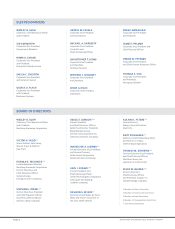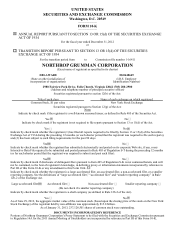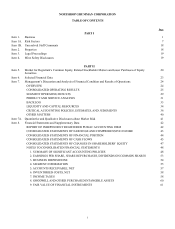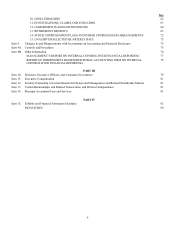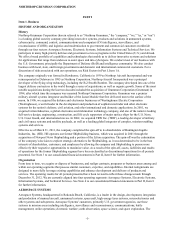Northrop Grumman 2012 Annual Report Download - page 15
Download and view the complete annual report
Please find page 15 of the 2012 Northrop Grumman annual report below. You can navigate through the pages in the report by either clicking on the pages listed below, or by using the keyword search tool below to find specific information within the annual report.NORTHROP GRUMMAN CORPORATION
-5-
property rights to and from third parties. The U.S. Government generally holds licenses to patents developed in the
performance of U.S. Government contracts, and may use or authorize others to use the inventions covered by these
patents. Although these intellectual property rights are important to the operation of our business, no existing patent,
license or other intellectual property right is of such importance that its loss or termination would, in our opinion,
have a material impact on our business. See Risk Factors in Part I, Item 1A.
RAW MATERIALS
We have not experienced significant delays in the supply or availability of raw materials, nor have we experienced a
significant price increase for raw materials, that would have a notable adverse effect on the company's consolidated
financial position, results of operations, or cash flows. See Risk Factors in Part I, Item 1A and Overview – Outlook
in Part II, Item 7.
EMPLOYEE RELATIONS
We believe that we maintain good relations with our 68,100 employees, of which approximately 3,300 are covered
by 17 collective bargaining agreements. We negotiated or re-negotiated eight of our collective bargaining
agreements in 2012 and expect to re-negotiate renewals for three of our collective bargaining agreements in 2013.
These negotiations had no material adverse effect on our results of operations. For risks associated with collective
bargaining agreements, see Risk Factors in Part I, Item 1A.
REGULATORY MATTERS
Government Contract Regulation
Our businesses are affected by numerous laws and regulations, including those relating to the award, administration
and performance of U.S. Government contracts. The U.S. Government generally has the ability to terminate our
contracts, in whole or in part, without prior notice, for convenience or for default based on performance. If a U.S.
Government contract were to be terminated for convenience, we generally would be protected by provisions
covering reimbursement for costs incurred on the contract and profit on those costs, but not the anticipated profit
that would have been earned had the contract been completed. In the unusual circumstance where a U.S.
Government contract does not have such termination protection, we attempt to mitigate the termination risk through
other means. Termination resulting from our default may expose us to liability and could have a material adverse
effect on our ability to compete for other contracts. The U.S. Government also has the ability to stop work under a
contract for a limited period of time for its convenience. In the event of a stop work order, we generally would be
protected by provisions covering reimbursement for costs incurred on the contract to date and for costs associated
with the temporary stoppage of work on the contract. However, such temporary stoppages and delays could
introduce inefficiencies for which we may not be able to negotiate full recovery from the U.S. Government, and
could ultimately result in termination for convenience or reduced future orders on certain contracts. Additionally, we
may be required to continue to perform for some period of time on certain of our U.S. Government contracts, even if
the U.S. Government is unable to make timely payments. See Risk Factors in Part I, Item 1A.
Certain programs with the U.S. Government that are prohibited by the customer from being publicly discussed in
detail are referred to as “restricted” in this Form 10-K. The consolidated financial statements and financial
information in this Form 10-K reflect the operating results of our entire company, including such restricted programs
under accounting principles generally accepted in the United States of America (GAAP).
Contracts
We generate the majority of our business from long-term contracts with the U.S. Government for development,
production, and support activities. Due to the long-term nature of our contracts with the U.S. Government and the
products and services covered by these contracts, we generally recognize revenue on the percentage of completion
method of accounting. Under the percentage of completion method of accounting, revenues are generally recognized
as costs are incurred (cost-to-cost method) or as units are delivered (units-of-delivery method). Unless otherwise
specified in a contract, allowable and allocable costs are billed to contracts with the U.S. Government under the
requirements of the Federal Acquisition Regulation (FAR) and Cost Accounting Standards (CAS) regulations.
Examples of costs incurred by us and not billed to the U.S. Government in accordance with the requirements of the
FAR and CAS regulations include, but are not limited to, certain legal costs, lobbying costs, charitable donations,
advertising costs and interest expense. Our long-term contracts typically fall into one of two broad categories:
Cost-type contracts – Cost-type contracts include cost plus fixed fee, award fee, and incentive fee contracts. Cost-
type contracts provide for reimbursement of the contractor’s allowable costs incurred plus a fee. Cost-type contracts
generally require that the contractor use its best efforts to accomplish the scope of the work within some specified
time and some stated dollar limitation. Fees on cost-type contracts can be fixed in terms of dollar value or



